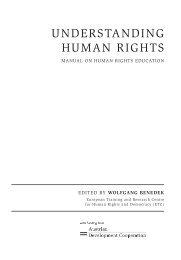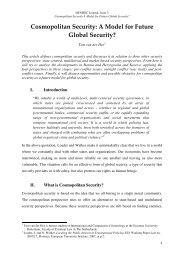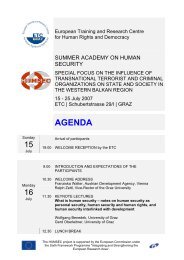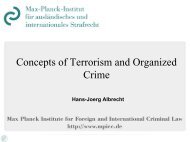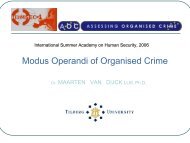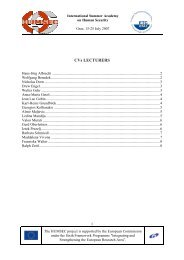Kosovo's Post-independence Inter-clan Conflict - HUMSEC
Kosovo's Post-independence Inter-clan Conflict - HUMSEC
Kosovo's Post-independence Inter-clan Conflict - HUMSEC
Create successful ePaper yourself
Turn your PDF publications into a flip-book with our unique Google optimized e-Paper software.
<strong>HUMSEC</strong> Journal, Issue 2<br />
Kosovo’s <strong>Post</strong>-<strong>independence</strong> <strong>Inter</strong>-<strong>clan</strong> <strong>Conflict</strong><br />
It is not clear whether Anton Cetta envisioned the reconciliation process to be a step towards<br />
a long-term solution to the blood feuds. The besa, in theory at least, is a short, timebound<br />
truce. It is likely that “the need for unity in the emergency circumstances of the Serbian<br />
takeover” of Kosovo, rather than a true commitment to completely do away with the<br />
practice of blood feuds, dictated Cetta’s appeal. 14<br />
The truce turned out to be short-lived. After the 78-day North Atlantic Treaty Organization<br />
(NATO) bombing of Kosovo and Serbia in 1999, cases of blood vengeance began reappearing.<br />
In the first four years after the war, the Council for the Defense of Human Rights and<br />
Freedoms in Prishtina recorded approximately 40 blood feud murders. 15 According to the<br />
Council’s President, Pajazit Nushi, many people who agreed to besa in the 1990s have “restarted<br />
the old family blood feuds.” 16 By December 2004, the number of blood feud murders<br />
reached 70, the majority of which had taken place in the mountainous regions of<br />
Dukagjini in the West, an area that includes the towns of Decan, Klina and Peja. 17<br />
The abovementioned explanation of Anton Cetta’s reconciliation movement corresponds to<br />
Lewis Coser and Georg Simmel’s causal explanations of social conflict. 18 The scholars hypothesize<br />
that in the presence of a common enemy, conflicting groups are likely to disregard<br />
their differences and unite against the common enemy. However, once the common<br />
threat is no longer a part of the equation, conflicting groups are likely to resume their confrontational<br />
behavior. In this respect, while the first eight years of post-war Kosovo have<br />
already seen a sharp increase in the number of blood feuds, the question whether this trend<br />
will continue after Kosovo’s <strong>independence</strong> is a legitimate one. Coser and Simmel’s theories<br />
would suggest a high likelihood for the escalation of blood feuds. After Kosovo’s <strong>independence</strong>,<br />
neither Serbia nor the United Nations Mission in Kosovo (UNMIK) would constitute<br />
a common enemy for the feuding <strong>clan</strong>s. Hence, in the absence of a common enemy,<br />
inter-<strong>clan</strong> tensions are likely to resume. One could argue, however, that Serbia, the principle<br />
enemy, was minimized with the end of the 1999 war. However, such limited interpretation<br />
of the situation between 1999 and 2007 omits the role of UNMIK, which could be perceived<br />
by <strong>clan</strong>s as a “quasi-enemy.” <strong>Inter</strong>national oversight of Kosovo politics prevents<br />
<strong>clan</strong>s from maximizing their wealth, power and status. While UNMIK is not literally an enemy,<br />
its presence and steering of Kosovo in directions according to UNMIK’s own liking<br />
14<br />
<strong>Inter</strong>national Crisis Group, Kosovo after Haradinaj, at p. 10.<br />
15<br />
Quoted in Bytyci, Fatos, Blood Feuds Revive in Unstable Kosovo.<br />
16<br />
Quoted in Bytyci, Fatos, Blood Feuds Revive in Unstable Kosovo.<br />
17<br />
Flottau, Renate, Kosovo: A Prime Minister with a Kalashnikov, Center for Research on Globalization, 1<br />
May 2007. Available online at:<br />
http://www.globalresearch.ca/index.php?context=viewArticle&code=FLO20041213&articleId=332.<br />
18<br />
See Coser, Lewis, The Functions of Social <strong>Conflict</strong>, Free Press, Glencoe, IL, 1956, and Simmel, Georg,<br />
<strong>Conflict</strong>, Free Press, Glencoe, IL, 1955.<br />
116



